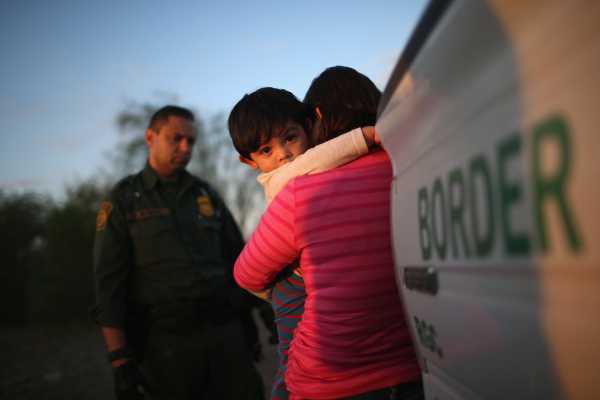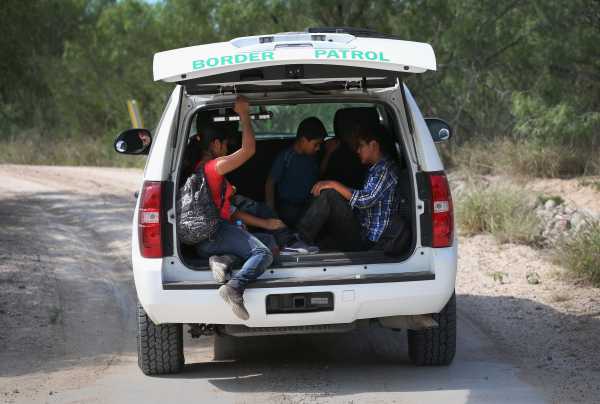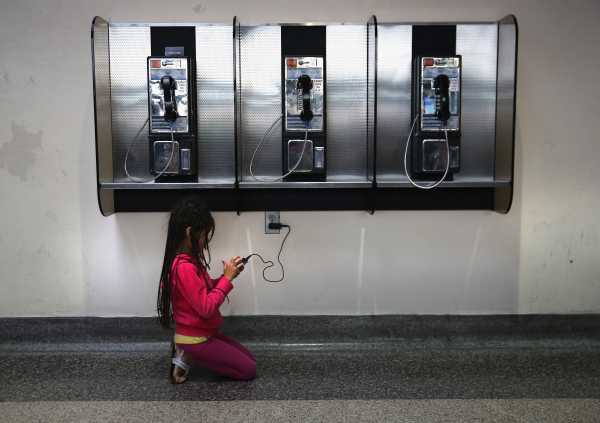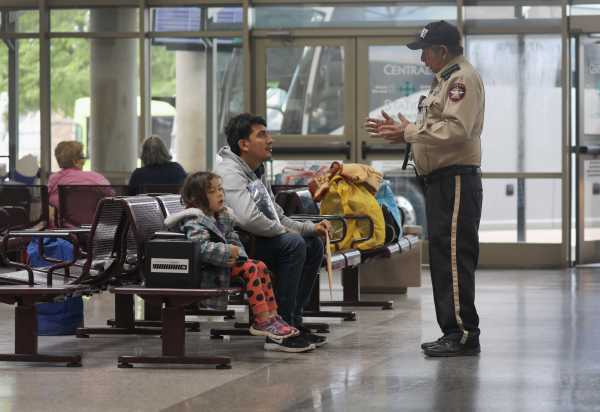
The separation of families who cross into the US from Mexico illegally is now official US government policy.
On Monday, Attorney General Jeff Sessions and Director of Immigration and Customs Enforcement (ICE) Thomas Homan announced that the Trump administration would adopt a zero-tolerance policy toward anyone caught crossing into the US by Border Patrol. All border crossers would be referred to the Department of Justice, and everyone referred would be prosecuted for the misdemeanor of illegal entry.
Everyone means everyone — including people seeking asylum from persecution (which anyone is legally entitled to do), and including parents who have entered the US with their children. And when adults are transferred to criminal custody, their children get treated as “unaccompanied minors,” as if they’d crossed the border alone, split from their parents and sent into the care of a totally separate government department.
“If you are smuggling a child,” as Sessions put it Monday, “then we will prosecute you and that child will be separated from you as required by law.”
In theory, the family separation isn’t indefinite, and could even be fairly brief. And asylum-seekers who present themselves at official ports of entry like road crossings will not be prosecuted (whereas crossing the US between ports of entry is a crime).
But the Trump administration is explicitly doing this to try to stop more families from coming to the US in the future. And their argument that prosecuting parents actually works to deter future border crossings relies on a “statistic” that their own data shows to be fake.
This is part of Trump’s agenda to end “catch and release” by detaining as many asylum seekers as possible
Trump spent the first year of his presidency bragging about the steep drop in border crossings after his inauguration. He’s spent the second year of his presidency freaking out that it didn’t last.
Border apprehensions are still very low, historically speaking. But they’re higher than they were last year — in large part because of children and families, many of whom are seeking asylum (most often from Guatemala, Honduras, and El Salvador),
Federal and international law prevent the government from deporting people back to danger. And it’s perfectly legal for someone to present herself for asylum at a port of entry, as the immigrants in the Central American “caravan” did last week.
But as the caravan showed, ports of entry often lack the resources to process asylum seekers quickly. Furthermore, some human rights groups accuse border officials of illegally refusing to accept asylum seekers trying to present themselves at entry points.
Many asylum seekers, therefore, choose to cross between ports of entry — to cross illegally into the US — and present themselves to Border Patrol.
When an asylum seeker crosses into the US illegally, she commits a federal misdemeanor. Under previous administrations, the Department of Homeland Security usually processed her asylum case first rather than referring her to the Department of Justice for federal prosecution. Even if DHS referred her for prosecution, DOJ wouldn’t usually bother to actually prosecute her before her asylum case was complete.
But Sessions, in particular, is convinced that many of these asylum claims are fraudulent, brought by “dirty immigration lawyers” to gum up the system. So DOJ and DHS have stepped up their efforts to detain as many asylum seekers as possible and deport as many of them as quickly as possible, in the name of ending “catch and release.”
In April, Sessions announced that everyone who got referred by DHS to DOJ for illegal entry would be charged with the misdemeanor and prosecuted by US attorneys. Now, DHS is announcing that it will refer everyone for prosecution — including asylum seekers with children.
The announcement completes a pipeline: All border crossers will be referred for prosecution, and everyone referred will be prosecuted.

The fake statistic at the heart of Trump’s case for prosecuting parents
The Trump administration has been engaging in family separation on a smaller scale for a long time. It started ramping up federal illegal entry prosecutions (including against asylum-seekers) during Trump’s first months in office. The New York Times reported in April that since October 2017, 700 families had been separated at the border. And from July to November 2017, the administration tested out a “zero tolerance” policy for parents in the El Paso sector of the border, covering western Texas and eastern New Mexico.
Administration officials trot out the El Paso pilot as evidence that “zero tolerance” prosecution works: that it leads to fewer families trying to cross the border illegally to begin with.
But their key statistic is entirely wrong.
The administration claims that after the pilot, illegal crossings of family members in El Paso dropped by 64 percent.
That statistic was used in an internal DHS memo urging Secretary Kirstjen Nielsen to adopt the zero-tolerance policy, as the Washington Post’s Maria Sacchetti reported in April. When a DHS official sent background information on the policy to Vox on Monday, it was the only statistic provided:
The federal government generally uses Border Patrol apprehensions as a proxy for illegal border crossings themselves (on the logic that the more people come through, the more of them will get caught). Customs and Border Protection reports how many members of family units — adults who arrive with one or more children — are apprehended at each border sector each month. According to those statistics, in July 2017, 231 family-unit members were apprehended in the El Paso sector. In November 2017, that figure was 379.
That’s a 64 percent increase in apprehensions — the opposite of what the administration’s statistic suggested.
Asked how they calculated a 64 percent decrease, a DHS official initially suggested that Vox was “missing a variable.” The official then sent a figure from an internal report that showed apprehensions of all unauthorized immigrants in the El Paso sector, not just family units, were 64 percent lower over October 1 to 26, 2017 than over October 1 to 26, 2016.
While there aren’t public statistics for that exact time period, border apprehensions across the entire US-Mexico border over the whole month of October 2017 dropped by 43 percent from the previous year, making it hard to understand why a 64 percent drop in one sector would be attributable to that policy. Furthermore, the original claim in the policy memo was specifically that crossings of families dropped.
It isn’t that prosecuting parents led more families to come. In fact, it’s possible that it really did have some sort of deterrent effect. Family-unit apprehensions increased much more from July to November 2017 across the other sectors of the US-Mexico border (110 percent) than they did in El Paso.
But the administration isn’t claiming that apprehensions in the El Paso sector rose less compared to other parts of the border as a result of zero tolerance. It’s claiming they dropped by nearly two-thirds. And that’s simply not the case.
Trump is codifying a policy of splitting up families

The Trump administration isn’t saying that separating families is the goal of their policy, or even that it’s an intended punishment. Even Sessions, whose reference to “smuggling children” lumped in parents with professional smugglers, didn’t go that far. But Sessions and other Trump officials aren’t leaving much leeway for discretion in individual cases. They are codifying family separation as an acceptable cost of crossing the border between ports of entry without papers.
An increasing share of border crossers seeking asylum come as “family units”: one or more adults with one or more children. (The Trump administration refers to them as “purported ‘family units’” to underline the fact that they could be lying about their family relationship.) And it’s much harder for the government to detain whole immigrant families than it is for them to detain adults.
Federal court rulings have set strict standards on the conditions under which families can be detained. Under the Obama administration, courts ruled that they couldn’t be kept in detention for more than 20 days.
That’s exactly the sort of “catch and release” the Trump administration is trying to prevent. Trump claims that once released, “nobody ever comes back” for their court dates. (The real number is a still-substantial 40 percent.)
The Trump administration’s solution, now codified in policy, is to stop treating them as families: to detain the parents as adults and place the children in the custody of Health and Human Services as “unaccompanied minors.”
They don’t have to charge parents in criminal court to separate them. But filing criminal charges and transferring defendants to the custody of the US Marshals Service requires children to be separated and sent into HHS custody.
Under the new policy, DHS emphasizes, parents will be reunited with their children once they are returned to ICE custody after their criminal case is completed. DOJ says that in most cases, an immigrant won’t be sent back to ICE custody until she’s finished serving her criminal sentence. That won’t be any longer than six months — the maximum sentence for a first-time illegal entry conviction — and may very well be less.
But it’s not clear how ICE is going to guarantee reunification. Some parents have ended up separated from their children for months, even after being released from immigration detention. And HHS has lost track of 1,500 unaccompanied children between October 2016 and December 2017, raising serious questions about how easily they could be reunited with their parents in ICE detention centers after the conclusion of a criminal case.
In some cases, according to immigration lawyers, parents separated from their children have begged to withdraw their asylum applications — on the logic that it would be easier for them to reunify their families in their home countries.

Family separation as a form of deterrence
The Trump administration is dedicating serious resources to doing this. Sessions announced Monday that the DOJ would send 35 prosecutors to the border to process these cases, but many more may be needed.
In March, 3,769 people were convicted of illegal entry in criminal courts — but 37,383 people were apprehended crossing into the US from Mexico. Illegal entry prosecutions already account for nearly a third of all criminal convictions (in March, they came to 31.7 percent); it’s not clear how many more prosecutors and judges it would take to prosecute 10 times as many people, or how that could be done without starving DOJ of the resources to prosecute other crimes.
In the most sympathetic light, the Trump administration — like the Obama administration before it — is trying to spare families the often dangerous journey through Central America and Mexico to the US, by making the endpoint of the journey less appealing.
But this only makes sense if families’ lives in their home countries really are safer than what they’d risk on the way to the US — something that in the case of many Central American families isn’t clear at all.
For that reason, national and international law are pretty clear that the US can’t detain an asylum seeker now just to send a message to other potential future asylum seekers. There has to be some sort of individualized assessment that this particular asylum seeker would skip out on her court hearing, or pose a risk to the US, if released.
If keeping someone in detention is too harsh a treatment for deterrence alone to justify, that’s all the more true of separating parents from their children.
The administration isn’t treating family separation as a punishment for illegal entry, just as a collateral consequence of it. But it’s a consequence of which they’re fully aware. They’re endorsing family separation as a policy, for anyone who makes the choice to forgo the wait (and the chance of rejection) at a port of entry and decides to cross the border between ports of entry instead.
They’re justifying their actions with a thin veneer of evidence — a statistic that’s not grounded in their own data — and beneath that, a blunt assertion: Separating families ought to deter future crossings, and if it doesn’t, it’s no less than people deserve anyway.
Sourse: vox.com






